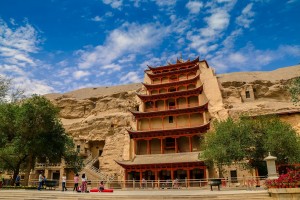 The Dunhuang Mogao Grottoes
The Dunhuang Mogao Grottoes
The Dunhuang Mogao Grottoes, located in Dunhuang City, Gansu Province, China, are the most well-preserved and largest Buddhist art site in the world , its history can be traced back to AD 366, excavated from the Sixteen Kingdoms period to the Yuan Dynasty, about 1000 years.There is no accurate account of the origin of the Mogao Grottoes. It is said that at that time, a monk named Le Zun dug the first cave and later continued to dig, and now there are 735 caves. Mogao Grottoes is one of the four ancient Chinese grottoes and one of the largest grottoes in the world, known as the "Exhibition Hall of Oriental sculpture art".
The reason why Dunhuang Mogao Grottoes are precious is that Dunhuang is a significant place in the Hexi Corridor. Since the sixteen States, the donors of each dynasty and each generation would invite excellent painters and craftsmen to paint Buddhist sutras and Buddha statues in the grottoes to decorate the grottoes and spread Buddhist beliefs. The creative level of different artists in different periods and the content of depicting the social life at that time constitute a rich study of Dunhuang culture and art.
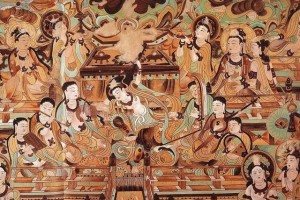 The Murals
The Murals
The Dunhuang Mogao Grottoes are divided into two main areas: the southern area, which contains the majority of the 487 caves, and the northern area with 248 caves. The murals and sculptures in the grottoes showcase a diverse range of styles, including the Tang style, Five Dynasties style, Northern style, and Tibetan Buddhist style. The Mogao Grottoes comprise 735 caves, housing approximately 45,000 square meters of murals, over 2,000 colored sculptures, and tens of thousands of scriptures and inscriptions. The art of the grottoes reached its pinnacle during the Sui and Tang Dynasties. During this period, the art forms of Mogao Grottoes were diverse. Most of the murals took earth red as the background color and used colors such as blue, green, ochre, and white. These murals and painted sculptures play a very significant role in the history of Chinese art, showing the unique charm of ancient Chinese art.
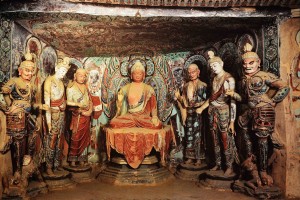 The Buddha Statues
The Buddha Statues
In addition to the murals, the colored sculptures in the Dunhuang Mogao Grottoes are also unique. These colorful sculptures include Buddha statues, Bodhisattvas, protecting gods, etc., beautiful in shape and lifelike, reflecting the exquisite level of ancient sculpture art. Colored sculptures play an important decorative and religious significance in the Mogao Grottoes, adding a mysterious and solemn atmosphere to the whole grottoes. Stepping into the Mogao Grottoes is like a journey through time and space. The murals in the caves vividly tell the life scenes, religious beliefs and artistic aesthetics of the ancient people. Each of the works here is unique, and they are either colorful or solemn, showing Buddhist art to its fullest. Standing in front of these great works, I couldn't help but marvel at the wisdom and talent of the ancients.
Dunhuang, a treasure in the desert, not only gives us a taste of the glory of ancient Chinese art, but also gives us a deeper understanding of the profound heritage of Chinese civilization. I hope this sharing can arouse your curiosity and yearning for Dunhuang. Our excavation journey will continue. Please look forward to more beautiful scenery!
· Chinese Name: 敦煌莫高窟
· Location: located 25 kilometers southeast of Dunhuang City, Gansu Province, China
· Area: 45000 square kilometers
· Opening Time: Peak Season (April 1 to November 30):08:00-18:00(Tickets will be checked at 15:30)
Off Season (December 1 to March 31):09:00-17:00
· Best Time to Visit: April to October
· Service Telephone:400-833-3715, 0937-8825000, 0937-8825166, 0937-8825066
Top Things To Do
Visit Dunhuang Mogao Crottoes
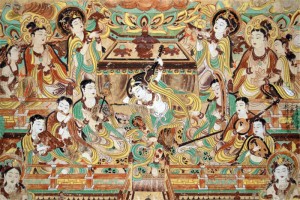 The Picture of Mural
The Picture of Mural
Dunhuang Mogao Grottoes has 735 caves, but only 60 Ordinary Caves (普窟) and 9 Special Caves (特窟) are open to the public as of 2024. Be sure to distinguish between online reservations for ordinary grottoes and on-site reservations for special grottoes when purchasing tickets. Ordinary Cave tickets provide access to eight caves and two movies, while Special Caves have varying prices for each cave. Each cave features unique statues and murals. The Ordinary Caves boast of beautiful clay sculptures and murals. However, the Special Caves are even more stunning with their vivid color reproduction and impeccable condition. As I stood in front of the Mogao Grottoes in Dunhuang, I was captivated by the millennia-old murals. I could feel the wisdom and creativity of the ancient artists as if transported through time. Each piece of work was a cultural treasure, showcasing the charm and splendor of ancient art.
Ticket: Peak Season (April to October): 238/ person, visit 8 caves; Off Season: 140/ person, visit 12 caves
100/ person, visit 4 caves
Watch Digital Movies
Dunhuang offers movie screenings in addition to cave visits, which are included in the price of admission. The first film Thousand Years of Mogao provides a historical background for visitors to better understand the history of the Mogao Grottoes. The second film on the ultra-high-definition ball screen, Dream Buddha Palace showcases the Buddha statues and murals in the caves, along with related stories that are both shocking and realistic. Watching it feels like being teleported into the cave itself. The total length of both films is 40 minutes.
Visit the Dunhuang Exhibition Center
 The Dunhuang Exhibition Center
The Dunhuang Exhibition Center
Dunhuang Grottoes Exhibition Center is the only institution in China dedicated to the protection and research of grotto cultural relics. The center features 8 1:1 replicas of caves. You can visit the exhibition center for free. It features a replica of a classical cave, a special exhibition area for cultural relics and artworks, and a video studio. The exhibition includes the creation of Dunhuang Mogao Grottoes, Dunhuang frescoes copy treasures, the creation process of Dunhuang Grottoes and the painting tools used by painters to draw the caves, the exquisite ancient ratio fabric found in Mogao Grottoes, the ancient manuscripts found in the Tibetan Scriptures Cave, and Dunhuang tile art.
Address: Mogao Grottoes scenic area
Opening hours: 09:30-17:30 in summer, 08:30-17:00 in winter
Visit Dunhuang Art Museum
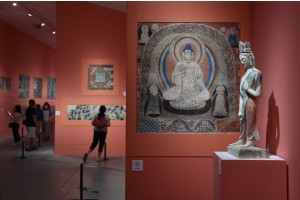 The Dunhuang Art Museum
The Dunhuang Art Museum
The Dunhuang Art Museum, under the Dunhuang Academy, features nearly 200 exhibits, including Dunhuang murals, painted sculptures, Dunhuang suicide letters, and classic replicas of caves. Focusing on Dunhuang's mural paintings from 1650, the exhibit showcases the highest painting achievements of each theme. If the Mogao Grottoes are too crowded and you can't see anything during peak hours, don't worry! Here, you can have a close look at the classic murals of Mogao Grottoes, along with thoughtful accompanying text explanations. There are also detailed descriptions of how the painting was done, what materials were used, and so on. It is not only the Mogao Grottoes but also includes part of the Yulin Grottoes, which is a place worth visiting.
Opening hours:Tuesday to Sunday 9:00-17:00



































